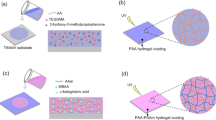Abstract
Poly(vinyl alcohol)/Hydroxylapatite (PVA/HA) composite hydrogel was prepared with poly(vinyl alcohol) and hydroxylapatite as raw materials, using the method of repeated freezing and thawing. The morphologies of PVA/HA composite hydrogel were observed by means of high-accuracy 3D profiler and scanning electron microscope (SEM). The compressive elastic modulus and the stress relaxation characteristics of PVA/HA composite hydrogel were measured using the flat-head cylinder indenter. The friction and wear tests between PVA/HA composite hydrogel and bovine knee articular cartilage were performed on the micro-tribometer. The worn morphologies of PVA/HA composite hydrogel were observed with environmental scanning electron microscope (ESEM). The results showed that PVA/HA composite hydrogel has the cross-link network microstructure which is similar to that of the natural bovine knee articular cartilages. With the increase of freezing-thawing cycles and the HA content, the degree of cross-link and the crystallization of PVA/HA composite hydrogel both increase, the elastic modulus increases evidently, the rate of stress relaxation is improved and the value of balance stress decreases. The friction coefficient decreases with the increase of the freezing-thawing cycles and the HA content. The more the freezing-thawing cycles are, the earlier the friction coefficient reaches the stable balance value. The friction deformation depth between PVA/HA composite hydrogel and bovine knee articular cartilage is inversely proportional to freezing-thawing cycles and the HA content. The main wear mechanisms of PVA/HA composite hydrogel are plastic flowing and adhesive flaking. The wear severity degree decreases with the increase of freezing-thawing cycles and the HA content.
Similar content being viewed by others
References
Suciu A N, Iwatsubo T, Matsuda M. Wear characteristics of a novel bearing system for artificial knee joint. JSME, Part C, 2004, 47(1): 209–217
Suciu A N, Iwatsubo T, Matsuda M. A study upon durability of the artificial knee joint with PVA hydrogel cartilage. JSME, Part C, 2004, 47(1): 199–208
Pan Y S, Xiong D S. Recent development on biotribology of poly (vinyl alcoho1) hydrogel (in Chinese). Tribology, 2006, 26(2): 188–192
Wang Y J, Zheng Y D, Liu Q, et al. The compounding in situ by precipitation of poly(vinyl alcohol) hydrogel with hydroxylapatite and investigation on the structure and properties (in Chinese). Chin J Biomed Eng, 2005, 24(2): 150–153
Zheng Y D, Wang Y J, Chen X F, et al. Characterization and properties of poly (vinyl alcoho1)/hydroxylapatite hydrogels prepared by compound in situ with sol-gel method (in Chinese). Chem J Chinese Univ, 2005, 26(9): 1735–1738
Covert R J, Ott R D, Ku D N. Friction characteristics of a potential articular cartilage biomaterial. Wear, 2003, 255: 1064–1068
Katta J K, Marcolongo M S, Lowrnan A M. Friction and wear characteristics of PVA/PVP hydrogels as synthetic articular cartilage. IEEE, 2004, 4: 142–143
Nanao H, Hosokawa S, Mori S. Relation between molecular structure of gels and friction properties under low load in water. Jpn Soc Triblogists, 2001, 46(12): 968–973
Freeman M E, Furey M J, Love B J, et al. Friction, wear, and lubrication of hydrogels as syntheticarticular cartilage. Wear, 24: 129–135
Gu Z Q, Ma Y Z, Gao J, et al. Development of artificial disc nucleus materials (semicrystalline polyvinyl alcohol hydrogel elastomers) (in Chinese). J Biomed Eng, 2004, 21(3): 347–349
Qian S H. Study on the mechanical and triboloigal behavior of bovine knee articular cartilages. Master’s Degree Thesis (in Chinese). Xuzhou: China Uiversity of Mining and Technology, 2006. 7–14
Ji B, Gao J, Ma Y Z, et al. Manufacture of prosthetic nucleus and analysis of stress-relaxation properties (in Chinese). J Univ Sci Technol Beijing, 2005, 27(5): 589–592
Liu M Z, Chen R S, Qian R Y. Investigation of swelling property of poly (vinyl alcohol) hydrogel (in Chinese). Acta Polymerica Sin, 1996, (2): 234–238
Xu F L, Li Y B, Li J D. Swelling properties of nano-hydroxylaptite/ polyvinyl alcohol hydrogel composite (in Chinese). J Mater Eng, 2005, (7): 15–18
Author information
Authors and Affiliations
Corresponding author
Additional information
Supported by Key Program of the National Natural Science Foundation of China (Grant No. 50535050), Program for New Century Excellent Talents in University (Grant No. NCET-06-0479) and Natural Science Foundation of Jiangsu Province (Grant No. BK2005403)
Rights and permissions
About this article
Cite this article
Zhang, D., Shen, Y. & Ge, S. Research on the friction and wear mechanism of Poly(vinyl alcohol)/hydroxylapatite composite hydrogel. Sci. China Ser. E-Technol. Sci. 52, 2474–2480 (2009). https://doi.org/10.1007/s11431-008-0301-8
Received:
Accepted:
Published:
Issue Date:
DOI: https://doi.org/10.1007/s11431-008-0301-8




